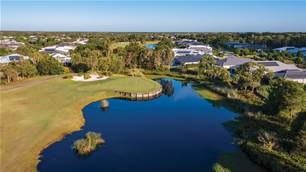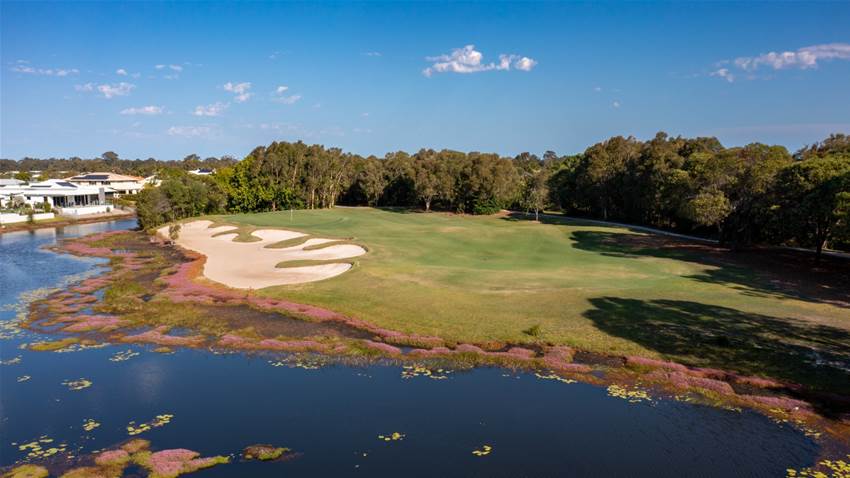Bevan Henzell had a long-held dream of building a championship golf course on his family property near Golden Beach, just south of Caloundra on Queensland’s Sunshine Coast.
In 1946, Bevan’s father, Roy Henzell Snr, who had opened Caloundra’s first real estate agency a decade earlier, purchased “1000 acres for £1000”; land best described as an impenetrable ti-tree swamp. Bevan never lost sight of the potential of the land, envisioning a transformation of the swampland into waterfront allotments alongside canals and constructing a golf course on the extracted tonnes of earth.
Bevan died in 1982, and one man’s dream became another man’s passion, as Roy Henzell Jnr, Bevan’s son, pushed ahead with development plans. Having prepared a full environmental impact study, Henzell applied for the first stage of their canal development, but the first real estate blocks weren’t sold until 1989. By the end of 1996, land sales had surpassed $20 million, and Pelican Waters was officially gazetted as a suburb.
Henzell then turned his attention to getting a golf course built. Greg Norman Golf Design was commissioned and if ever there was a design team that could successfully transform swampland into a golfing gem, it was Norman and his then design partner, Bob Harrison.
In the late 1990s and early 2000s, Norman and Harrison were the busiest design company in Australia as the golf course real estate boom gripped the country. And it seemed that no matter what challenges the landscape presented, Norman and Harrison would be able to create a course that, upon opening, would be considered among the top-100 courses in the country. In Melbourne, they created Sanctuary Lakes from flat, lifeless salt pan, while on the Gold Coast, they raised The Glades out of a swamp. All of this was happening at the same time as Henzell was negotiating to get their expertise on board at Pelican Waters.
In developing Pelican Waters, huge lakes were carved out and the sandy soil used to build up the golf course and residential areas. Vast areas of wetlands were created to attract birdlife and provide an attractive backdrop to several holes.
In ‘moving heaven and earth’, Messrs Norman and Harrison had a relatively blank canvas to work with, which one would assume presents a more difficult task in golf course design than working with a natural landscape.

The course was officially opened in January 2000 and debuted at No.10 in the then resort course rankings (a precursor to Golf Australia magazine’s biennial Top-100 Public Access Course rankings).
Pelican Waters’ design immediately impressed as interesting, strategic, and challenging. Norman and Harrison had been inspired by the creations of Alister MacKenzie and other great architects of his era in creating courses with intriguing short par-4s, risk-and-reward par-5s and punchbowl greens. They are of the MacKenzie school when it comes to bunkering, which can be confusing when observing the course under a hot Queensland sun and visually being transported to the heart of the Melbourne Sandbelt.
“Pelican Waters was another flat and featureless site which was reshaped from
start to finish,” Harrison recalls. “Once again, very sophisticated contour drawings had to prescribe good golf and satisfy flood requirements.

“The landscape in the roughs was created by transporting sand from the south of the site which contained the seeds of a natural heathland. The heathland then regenerated to form an attractive, natural landscape.”
There have been several changes of ownership since that opening day in 2000, and all have tried to capitalise on the first-class quality of the course and the idyllic Sunshine Coast location by developing an adjoining real estate masterplan. Several development plans were put before the local council over the years but failed to gain approval.
All that changed with the current owner, the Queensland-based Palm Lake Group, one of this country’s biggest developers of over-50s residential lifestyle communities. Palm Lake Group purchased the golf course and an adjoining 20-hectare development site in 2018.

Within two years, the company gained approval for a $70 million project involving the reconfiguration of the Pelican Waters course, establishing a hi-tech driving range and short game facility as well as construction of the adjoining over-50s Palm Lake Resort including 320 custom-designed homes, all with water frontage or direct golf course access.
The club hosted the 2021 Queensland Open and then closed the course to the public as Norman’s design company oversaw the creation of new holes, and redesign of several others, to replace the loss of the original 1st, 2nd, 8th and 9th holes, which would become part of the new residential development.
The nines have now been reversed from the original order of play, and Norman has signed off on new designs that now play as the 10th, 11th, 17th and 18th holes. A new green complex was created on the 7th, which now plays as the 16th, which was extended to turn the hole into a par-5. Putting out on the final green now has the added pressure of people watching from the clubhouse or the adjoining resort tower.

The ‘new’ Pelican Waters layout officially opened for play on August 1 this year, with a ceremonial first drive from the 10th tee by Greg Norman’s mum and Pelican Waters Golf Club member, Toini.
Over time with the growing in of the surrounding landscape, the new holes will offer a more connected feel to the original holes. Of these holes, the short par-4 11th will be a talking point for players. A lake lies right of the fairway before a canal cuts the fairway off from the final approach to the green. Most players will just need to avoid two bunkers – through the end of the fairway – and the water by finding the expansive fairway and leaving a short iron or wedge into the green. In the right conditions, adventurous bigger hitters might like their chances of reaching the green from the tee, but it’s a huge risk.
Pelican Waters’ new penultimate hole is a short par-3 with a massive green, protected by equally large bunkers, and shaped to contain different sections placing a premium on club selection and accuracy from close range to avoid facing a difficult first putt.
“The course now has five par-3s, with three on the back nine, but the 17th is just something very different to the others,” said course superintendent Troy Muir, who has worked at Pelican Waters since 1999. “Prior to the renovation all the par-3s played to a similar length, about 155-160 metres, with the only difference being the direction of each hole dictating club selection based on the wind.

“But the 17th is only 120 metres and the key to making a good score there is leaving your ball in the same section of the green as the flag. You certainly must think about what you’re doing there. There’s a swale behind the green with a bunker and, when you’re standing on the tee, it certainly tricks you up.”
Muir said all five new greens are sizable, each at more than 600 square metres, but have been designed to add another layer to the challenge of scoring well here.
“For example, the new 18th green is quite large but the back section of the green drops away and slopes down towards the lake beside the green,” he said.
Muir said more than 30 bunkers across the layout have also been significantly upgraded during renovation.
“We have treated those bunkers with capillary concrete, which is a 50mm porous layer of concrete over the entire bunker and the sand goes on top of that,” Muir said.
“It has been a game-changer, particularly for a course that can get a lot of rainfall. It eliminates washouts, it drains better, maintains its colour and is easier to maintain.”
To maintain consistent turf quality across all the holes, Muir and his team scarified the Bermuda Tifdwarf grass on the old greens to establish the new putting surfaces, while Riley’s Supersport couch was cut from some of the existing fairways to grow on the first few holes.

“Some of the areas were also stolonised from existing fairway grass,” Muir said. “The whole process was to maintain a level of consistency across the entire course.”
Mission accomplished.
Pelican Waters was in terrific condition when I visited to compile this review, only a few weeks after the course re-opened. The putting surfaces, in particular, were almost flawless and rolling smooth and at a good speed.
And there’s still plenty to like about Pelican Waters’ original holes, which rely on strategy rather than length to test your golfing mettle.
The holes of what is now the front nine feel more secluded from the surrounding residential estate than they once were as the green barrier has had two decades of maturing.
For mine, the best holes on this side are the par-3 5th and the two long par-4s to close the nine.
At 160 metres, the 5th features water and a 100-metre-long deep bunker, cutting the fairway off from the lake to the left. It’s not too hard, but it is definitely a memorable hole.
The stretch of holes from the 6th to the 9th are carved from native bushland featuring hundreds of Grass trees, Sawsedge, Wullum Boronia, Smoke Bush, Vanilla Lily, Curly Wigs and Foxtail plants. Native grasses in the rough also give the impression this course has been here so much longer than it has.
The 8th is a real sleeper hole. It is a 383-metre tight driving hole that doglegs sharply right with tall timbers closely lining the edges of the fairway. The playing line is a little wider on the next, a 420-metre par-4 that winds left. The ideal line off the tee is just left of centre to shorten the hole slightly, but this brings a large fairway bunker into play. Go the long way and there is little trouble to speak of, but you are left with a long approach into the green.
The course is not the only impressive aspect of Pelican Waters. There is a new world class short game practice area in front of the clubhouse as well as a mini golf course.
There will also be a state-of-the-art driving range and coaching facility, which will become the home of PGA teaching pro Grant Field, the renowned coach of 2022 Open champion Cameron Smith.
You can’t help but think Bevan Henzell would be pretty happy with how his dream has turned out.
FACT FILE
LOCATION: Mahogany Drive, Pelican Waters, Queensland.
CONTACT: (07) 5437 5000.
WEBSITE: www.pelicanwatersgolfclub.com.au
DESIGNERS: Greg Norman and Bob Harrison (2000); Greg Norman Golf Design (2023).
PLAYING SURFACES: Bermuda Tifdwarf (greens), Riley’s Supersport couch (fairways), Santa Ana couch (tees).
COURSE SUPERINTENDENT: Troy Muir.
PGA PROFESSIONALS: Grant Field and Dale Williamson.
GREEN FEE: $140 (18 holes).
Related Articles

Travel Feature: Golf’s Sunny Side

Review: Omaha Beach Golf Club













